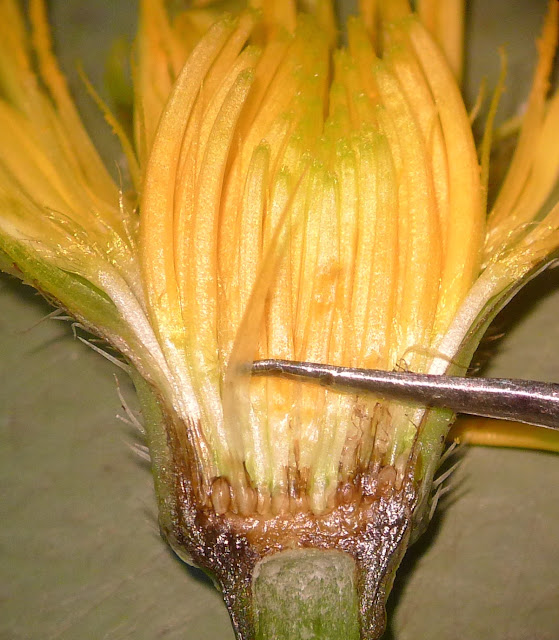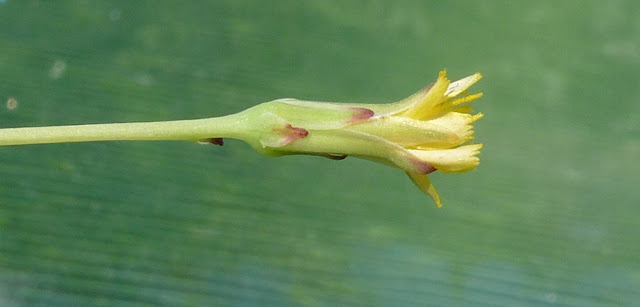Catsear is widespread and common throughout the British Is. whereas Smooth Catsear is limited mainly to East Anglia and a few localised records in other parts of Britain.
Both fall into that group of 'Yellow Dandelions' which include Hawkbits, Hawkbeards and Sowthistles that have ray-florets only. Typical flower structure is shown below shows how these flowers are actually made up of many flowers grouped together, hence the old fashioned term 'composite'.
Introduction. Whats makes a Cat's-Ear.
Cat's Ears have a plant structure consisting of a rosette of leaves from which the flowering stem(s) rises. It can be branched to support several flowers or unbranched supporting a single flower. The flowering stems do not normally have any leaves but have small CAT-EARS, triangular scales which are often quoted as a key ID feature. I am not sure how useful this feature is as a ID feature as other species can also have similar scales.
The key difference which separates all the Cats-ears from other yellow composites is a feature which is quite hard to see and is not shown on the diagram above. Cats-ears have a long almost clear scale which forms a partial tube around each achene. Because they are almost transparent they are easy to miss.
Presented with a hard atypical plant to identify, the expert botanist cuts the flower in half and looks through his magnifier to confirm his opinion that it's a Cat's-ear.
 |
| Smooth Cat's Ear showing the long scales that partially surround the achene. |
 |
| A scale is highlighted by the spike used to pull it forward. Not easy to see. White sap turns brown. |
 |
| Typical Plant |
 |
| Simple plant with one branched stem and showing possible variation in leaf shape. |
 Leaf shape is variable, wavy edged to deeply lobed but always very hairy with simple hairs ( no splits or hooks). Leaves are green and do not have the tendency to turn red as they can do in Smooth Cat's-ear.
Leaf shape is variable, wavy edged to deeply lobed but always very hairy with simple hairs ( no splits or hooks). Leaves are green and do not have the tendency to turn red as they can do in Smooth Cat's-ear.The Flower Head.
The involucre bracts hold several features of interest. The stem has no hairs and becomes wider just before the head but there is always a step. The bracts form a shape that is compact, wide and short unlike Smooth Cat's-ear bracts which have a much more elongated shape. A unique feature is the 'Cockscomb' of curved hairs which is normally present on the longer inner bracts but may also be present on other bracts to a lesser extent. In addition to the 'Cockscomb' there are white hairs that run down the centre line of the bracts. A feature not normally noted in the field guides is that most Cat's-ears have a prominent pale line down the middle of the bracts. This is very prominent in the photo above but occasionally may not be present. It is however a very quick and easy ID feature which I find useful.
As always plants show variation on the amount of hairs and extreme examples can have no 'Cockscomb' so the combination of features should be looked for.
An example of variation is this example which has prominent Cockscomb but lacks the white hairs. It does have the pale centre line. A close up of a Cockscomb follows.The hairs are strong, often slightly curved and normally dark ( from green to black)
 |
| Cockscomb of Cat's-Ear ( H. radicata) |
 |
| H.radicata extreme without hairs but with red tipped bracts. |
More variation. A example with no hairs, no Cockscomb or white hairs. The pale centre line is nicely present plus another very common feature not shown in the previous photos, the bracts often have red tips.
 |
| Inner bracts can be long and turn yellow at the tips. |
Not all flowers of H. radicata show this feature but it may be a feature worth looking for. It may only develop through growth as the flower matures? The design of the bracts vs the petals is very different but the fact the tips turn to the same shade of yellow indicates some connection between them. Why not stay green to the tip?.
The red tips are very common and can be very dark on some flowers. This photo shows the outer banding of grey on the petals which is also quite common. Banding colour can vary (silver white through to dark grey) and is a feature shared with many other yellow composites.
 |
| Lesser Hawkbit Cat's-ear Autumn Hawkbit |
Smooth Cat's-Ear ( Hypochaeris glabra)
Basic structure of a rosette of leaves and normally unbranched flower stems that are not always as upright as Cat's-ear. Whole plant is not as robust looking as Cat's-ear. Note also the sandy soil which is the preferred ground. Having said that some plants do have upright branched stems.
 |
| Upright and branched stem, Spain. |
 |
| Leaf rosette of Smooth Cat's-ear. |
 |
| Red leaf of Smooth Cat's-ear with no hairs ( usually has side hairs at a minimum) |
 |
| Example of a red leaf with more hairs that usual and was a hybrid. |
One final comment on structure. Although some plants can grow quite large with stem up to 40cm most are smaller and some can be tiny. The smallest I have seen had just two leaves 3mm long by 1mm wide and yet this tiny plant had put up a flowering stem with a tiny head of about 1mm diameter. Why it did not grow larger before attempting to flower I do not know.
The major difference between Cat's-ear and Smooth Cat's-ear is the shape of the flower head being long and narrow. The stem has the Cat's-ears and these are red at the edges, like the bracts.
 |
| Long and narrow with bracts edged with red is typical of Smooth Cat's-ear. |
 |
| The example that does not have the red edges seen in Spain. |
 |
| Another flower with slightly more red, same group of flowers in Spain. |
 |
| Short yellow petals are pale yellow. |
 |
| No hairs, pale center line, Red edges, Short Petals. |
First problem is finding a flower that is open as flowers remain closed most of the time and only open for a hour or two in late morning when in full sun. Petals are pale yellow, almost white on the underside.
 |
| Red limited to tip of bracts with pale edging. |
Final feature is the achenes, which can have some beaked and outer ones un-beaked which is a very distinct feature of Smooth Cat's-ear.
 |
| Outer achene not beaked ( 7 o'clock) unlike the beaked majority. |
 |
| Un-beaked achene of Smooth Cat's-Ear |
 |
| Beaked achene of Smooth Cat's-ear |
Hybrid (Hypochaeris radicata X H. glabra) = Hypochaeris X intermedia
I was fortunate that Alan Leslie found a site near Fordham in Cambridgeshire where both Cat's-ear (H. radicata) and Smooth Cat's-ear (H.glabra ) were growing together and he had found several hybrid plants. He invited me along to take a few pictures.
 |
| Hybrid Cat's-ear which petals slightly longer than Smooth cat's-ear. |
The main key ID feature is often stated as the petal length being intermediate between the very short petal extension beyond the bracts in Smooth Cat's-ear and the much longer petals of Cat's-ear.
With both species present and with open flowers, this was easy way to find a Hybrid.
The problem comes when the flowers are not open which is most of the time. Based on the photos taken I think even with closed flowers the bracts can give away the features of a Hybrid.
The above photo does not have the very narrow shape of a Smooth Cat's-ear. The red on the bracts is more like Smooth Cat's-ear in its extent. Both species have the pale centre line. The 'cockscomb' is present although limited. Smooth Cat's-ear does not have this. This example is about half way between in terms of the involucre bracts.
 |
| Hybrid Cat's-ear |
Another open flower with petals too long for Smooth Cat's-ear but too short for Cat's-ear. It has the most tiny 'cockscomb' present on some of the lowest inner bracts. The petal banding is pale greyish whereas Smooth Cat's-ear tends to have almost white banding however how reliable this feature is , is not certain. The involucre bracts form a shape which is not a thin as in Smooth Cat's-ear and it may be a Smooth Cat's-ear bud that is in the left of the photo from a different plant for comparison.
The red tips on the bracts are not limited to the tip as in Cat's-ear but extend down the edges.
 |
| Hybrid Cat's-ear more towards the Smooth Cat's-ear end of the spectrum. |
This flower shows the intermediate petal length well, but in may ways has features of Smooth Cat's-ear with no 'cockscomb' , red edging to the bracts and that thin shape. If this flower was closed it would be easy to miss being a Hybrid and might be seen as a Smooth Cat's-ear.
Example of a flower past its best and closed. The narrow shape is good for Smooth cat's-ear but there is Cockscomb present and the bract tips are just like Cats'-ear being dark and limited to the tip. The shape is the feature that suggests this is a hybrid.
 |
| Hybrid Cat's-ear |
The final photos shows a hybrid flower which shows the petal length just a little longer than might be expected with a Smooth Cat's-ear and the shape is not quite as narrow as one might expect. The bracts have no 'cockscomb ' and have the red edging more like a Smooth cat's-ear but it's a close call.
One of the longest inner bracts has turned yellow as seen in previous photos of Cat's-ear.
Conclusion.
With open flowers the hybrids are not too difficult to spot mainly based on the length of the petals but as these photos show there is some variation in whether they lie in the middle of the two species or are more like one of the parents.
When the flowers are not open, it becomes much more difficult but shape, extent of the red edging and the presence of the Cockscomb are factors which help in making an identification. It would appear from this brief encounter that hybrids that lie half way between these species are fairly straight forward but because some hybrids are fertile and backcross a whole range of hybrids can occur, some being very close to either parent. These would probably be very difficult to spot.
One factor that was not checked out was how hairy the leaves are on the hybrids, maybe next year.
Many thanks to Alan Leslie for showing me the site.
Peter Leonard
21st December 2018





This comment has been removed by a blog administrator.
ReplyDelete